 Menu
Menu
|
Function To show the magnetic field created by a current. |
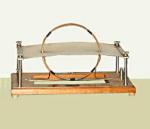
| ||
|
|||
|
Description A transparent sheet supported horizontally by a frame is crossed by the turns of a solenoid. By strewing the sheet with iron filing we can see the state of the force lines inside the solenoid and around the turns in the plane of the sheet. To make the magnetic spectra more evident without increasing the current intensity we have more turns of insulated wire placed perpendicularly to the celluloid plane. We make a 5-10 A current flow and with light pushes on the sheet we help the orientation and the distribution of the filing along the field lines. By holding over the ring the right hand with the fingers disposed in the direction of the current, we can verify that the North side of the ring is on the side of the thumb. A magnetic needle placed on the sheet will confirm it. | |||
|
Function To show the magnetic field created by a current. |
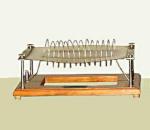
| ||
|
|||
|
Description A transparent sheet supported horizontally by a frame is crossed by the turns of a solenoid. By strewing the sheet with iron filing we can see the state of the force lines inside the solenoid and around the turns in the plane of the sheet. To make the magnetic spectra more evident without increasing the current intensity we have more turns of insulated wire placed perpendicularly to the celluloid plane. We make a 5-10 A current flow and with light pushes on the sheet we help the orientation and the distribution of the filing along the field lines. By holding over the ring the right hand with the fingers disposed in the direction of the current, we can verify that the North side of the ring is on the side of the thumb. A magnetic needle placed on the sheet will confirm it. | |||
|
Function Interaction between currents. |
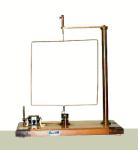
| ||
|
|||
|
Description This model works with weak currents. We can easily change the mobile circuits and they are suspended from a silk thread the height of which we can regulate. It does not exercise any directional force, while the friction is practically null. Few cell elements are enough to obtain good results with the solenoid, with the rectangular and the circular frame and with the astatic frame. The outlet is made by two superimposed iron wells connected to a switch. A separated basis with two columns and two binding posts holds the rectilinear conductor or the conductor with the corrugated return, that must interact with the mobile circuits. | |||
|
Function Transformation of electric energy into mechanical energy. |
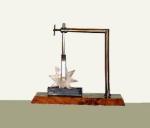
| ||
|
|||
|
Description The apparatus is made of a circuit that includes a disk or a toothed wheel. The mobile contact of the disk is made of mercury placed in a tank of conducting material. The experiments give a continuous rotation of the disk. Every radius of the disk or of the toothed wheel behaves like thread crossed by a current on the basis of Laplace’s law and the left hand rule. | |||
|
Function To show the interaction between currents. |
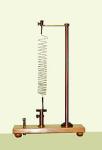
| ||
|
|||
|
Description The main part is formed by an elastic solenoid of aluminium wire suspended vertically, and the lower end (with a weight and a tip) is in contact with the mercury contained in a tank. When the current flows, the turns of the solenoids are attracted one to the other, the solenoid gets shorter and the tip comes out of the mercury, interrupting the current. When the attraction between the turns is stopped the tip goes down and re-establishes the contact, resulting in a vertical oscillation. If we apply an iron core, this receives the magnetic induction and adds its own action to that of the turns. | |||
|
Function To show the magnetic effect of the direct current. |

| ||
|
|||
|
Description The electromagnet is suspended to a brass column with an iron basis. It is made of a U iron rod on which is wound a hard-wire painted with sealing wax. By connecting the electromagnet to a cell, the electromagnet attracts a little metallic anchor given as equipment. | |||
|
Function To show the magnetic properties of the solenoids, to magnetise needles and steel bars and to emphasize the sucking force of the solenoids. |

| ||
|
|||
|
Description If we introduce partially in the coil the glass tube that accompanies it, we can verify that an iron cylinder, placed at the free end of the tube, is sucked violently by the coil when the current flows. | |||
|
Function To show an utilization of an electromagnet. |
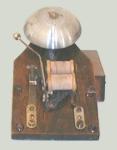
| ||
|
|||
|
Description The hammer of the bell is controlled by an electromagnet. By closing the circuit the hammer is attracted by the electromagnet. The shifting of the hammer provokes the opening of the circuit and the demagnetisation of the electromagnet. In this way, thanks to a recall spring, the hammer returns to its previous place thus closing again the circuit and so on. During this movement the hammer strikes the bell. | |||